



Feasibility of On-Farm Broiler Litter Combustion
By Thomas A. Costello,P.e.,Biological and Agricultural Engineering Department, University of Arkansas and published in Avian Advice.Introduction
Poultry litter is a resource that many growers have consistently used to fertilize pastures. However, poultry growers in sensitive watersheds are searching for alternatives to conventional land application. Litter can be burned in a furnace and the heat can be used for space-heating the broiler houses and might offer an alternative to land application. Propane or natural gas saved by utilizing the heat from combustion of litter might provide an economic incentive to justify the investment in the furnace system. However, it is important to examine the facts before investing in an on-farm litter burning furnace. Therefore, we decided to test a litter burning furnace. The purpose of this test was to determine if on-farm litter burning is feasible. An additional objective was to aid growers in making decisions about furnaces by providing details on thermal performance (i.e., the rate of heat output and the efficiency of the furnace), bulk material flow (i.e., daily and annual amounts of litter needed and ash produced), economic implications, management requirements and environmental repercussions. This article provides a summary of the results from the demonstration.
Furnace System Description
A broiler litter-fired furnace prototype, fabricated by Lynndale Systems, Inc., Harrison, Arkansas, was used in the test. The furnace was installed at House 1, UA Applied Broiler Research Farm (ABRF), near Savoy, Arkansas. The furnace used a direct combustion process with fan-forced delivery of combustion air. House air was drawn through air filters into the furnace and through an air-to-air heat exchanger. This arrangement was designed to extract energy from the hot exhaust gases and to transfer the energy to the air stream which was directed back into the house. Six, 18-inch high velocity stirring fans were used to promote distribution of the heated air longitudinally within the house.
Automatic control of the furnace components was accomplished using an electronic data logger (Campbell Scientific, model 21X, Logan, Utah). Whenever the house thermostat called for heat, a linear actuator moved a flapper valve to direct the heated air into the house (and exhausted the heated air when the thermostat was satisfied).
The broiler litter used as fuel in the test was taken from the Savoy farm during an annual cleanout in spring, 2005. It was stored for over a year in a bunker (covered pile on a concrete pad) adjacent to House 1. During the furnace test, litter was removed from the pile using the front-end loader on a tractor as needed and placed in a large hopper that could hold about 1 _ front-end loader buckets. A chain conveyor moved the litter from the outside hopper to a small surge tank above the furnace. As the furnace consumed fuel, it was metered into the combustion chamber.
Ash accumulated in an ash bin which was cleaned out manually every 1-3 days of operation. After removal, the ash was stored in covered plastic bins.
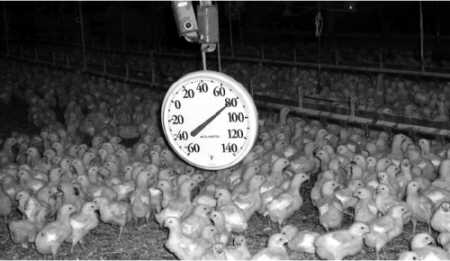
Testing:
The furnace system was operated during 2 grow-outs of birds from August 1, 2006 to November 24, 2006. The furnace supplied heat, as needed, to House 1 (a solid-side wall, tunnel ventilated house) at the ABRF. Measurements of fuel use, ash accumulation and heat extracted were obtained using digital scales, thermocouple probes and electronic data collection. The data were analyzed to document furnace performance and to provide a basis for assessing the feasibility of the system.
The data in Table 1 were from the second growout of the demonstration when the furnace prototype was operated automatically. In the table, the column labeled .Heat Extracted ' represents the total amount of heat generated from the litter burned on that day, while the column labeled .Heat Delivered' represents the amount of heat actually delivered into the chicken house. Due to mild weather, the broiler house thermostat did not call for heat in the latter part of the growout when the birds were large. On these days, the furnace was often operated with the heat exhausted outside the house. .Peak Output' is the maximum amount of heat generated per hour on that day. The data under .Cumulative Litter Consumed' and .Cumulative Ash Produced' represent running totals of the mass of litter burned and ash produced during the test.
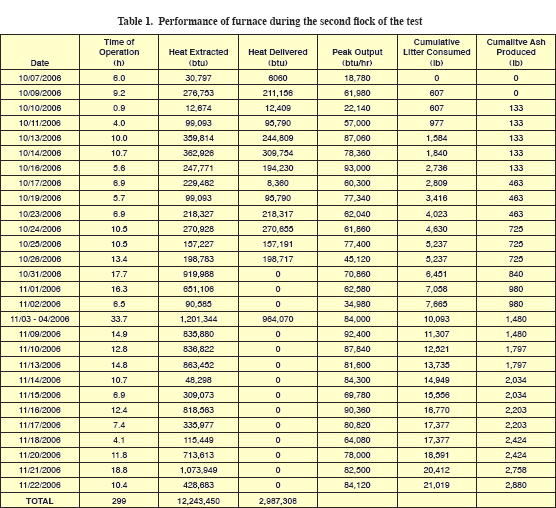
Over the 7 week period, the furnace was operated about 300 hours and produced over 12 million btu of heat (equivalent to about 133 gallons of propane). Approximately 10 tons of litter was combusted, producing an accumulated ash mass of about 1.4 tons (3 cubic yards). The average litter feed-rate was 70 lb/hour and the peak heat output was 93,000 btu/h. The furnace system efficiency (assuming litter has an energy content of about 4500 btu/lb) was 13%.

Properties of Litter and Ash:
Samples of litter and ash were collected and analyzed. The properties are summarized in Table 2 (right).
The energy content listed is for completely dried litter. Net energy values would be reduced to account for moisture normally present in litter. These test results for litter energy are consistent with other data which suggests a general net energy for broiler litter of about 4500 btu/lb. Litter quality will affect net energy. Wetter litter will have lower net energy content. Although we have not measured it, we can presume that litter that has not been stored for a long storage period would have higher energy content.
The fact that the ash includes 4% carbon indicates that either the litter was not completely combusted or that some unburned fuel sifted into the ash pan. Design improvements could be targeted to capture this energy to improve furnace system efficiency.
Since the process of burning removes organic matter (carbon), the ash tends to accumulate and concentrate the mineral, non-volatile litter constituents. Thus, we would expect ash would contain higher concentrations of minerals compared to the original litter. The elevated phosphorus (P) content has both pro's and con's. Litter derived P that remains in the ash is one reason that farmers in sensitive watersheds should probably not apply ash as a soil amendment unless soil tests indicate that the receiving crop does indeed need supplemental P. Therefore, most growers will be looking for an off-farm, out-of-watershed market for the ash. The elevated P content would make the material more attractive as a fertilizer to potential buyers outside the region.
Emissions and Air Quality Impacts:
Emissions out of the stack have important implications. Emissions of certain gases provide an indication of the extent of combustion. Other gases may contribute to air pollution. Thus, the quality of the stack gases needs to be checked so that we can insure that we are simply trading water pollution problems for air pollution problems. In addition, emissions problems might lead to regulation of such furnaces in the future.
The contents of the exhaust stack were spot checked periodically during the test. A portable combustion analyzer was used to probe the gas and measure its constituents. The results are listed in Table 3.
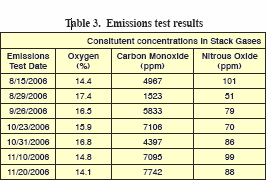
The measured levels of carbon monoxide (CO) were excessive. This gas is an intermediate combustion product that contains a lot of energy. Its presence at these concentrations represents lost heat and incomplete combustion. The potential exists to improve combustion in subsequent furnace designs so that CO levels are reduced and more energy (improved system efficiency) is extracted.
Levels of nitrous oxide (NO) were not excessive. Emissions of NOx from other sources (such as automobiles) contribute to air pollution in many urban areas. Changes to furnace design, particularly those that may lead to more complete combustion, could inadvertently increase NO emissions. So, this gas should continue to be monitored in tests following any combustion design changes.
The laboratory analysis of the litter indicates that it is composed of approximately 21% ash (inert minerals that cannot be combusted). In our testing, we were only able to recover about 12% of the litter weight as ash. The difference may be caused by very small particles of ash being exhausted up the stack (particulate emissions). Particulate emissions were not measured in this project. Further study is needed to see if particulate emissions represent a significant transport process that might carry litter constituents (such as minerals or trace metals) from the furnace to surrounding land.
Management Requirements:
During the second flock, when automatic controls were used, the furnace operation required one full-time operator. The operator was needed since the test had special monitoring/ measurement requirements. While some mechanical failures did occur which interrupted the operation of the furnace, these problems should be fixed before a commercial system is on the market.
In routine operation, growers would not need the sophisticated monitoring equipment used in the test. Growers would probably need to add litter to the hopper approximately 2-4 loads per day, depending upon the heat demand (how cold it is outside and how big are the birds). While at the furnace to load litter, the farmer would likely check furnace operation and verify that all was well. This should take about 15-30 minutes of labor per day. Manual unloading of ash should take about 30 minutes every 1-3 days. However, a commercial furnace may include automatic ash handling.
Economic Feasibility
The demonstration was successful in showing the technical feasibility of burning 100% litter in a direct-combustion furnace on the farm. Yet, the total heat delivery rate and system efficiency were lower than we had hoped. Modifications to the design of the furnace we tested might result in improved performance, increasing peak heat output and efficiency.
We can make some estimates as to the needed furnace performance that will result in a system that will pay for itself. Let's say that a grower decides to purchase a litter furnace and expects the furnace to eliminate about 80% of the annual fuel (e.g., propane) use for space heating. What furnace heat rate would meet this 80% requirement? The data in Table 4 below are based upon gas usage from the ABRF over 15 flocks and show that a furnace heat rate of 175,000 btu/h would meet about 40% of the annual load operating on its own and about 80% of the annual load when supplemented with existing propane heaters. So, if the target is 80% fuel savings, then the furnace needs to meet a 175,000 btu/h specification.
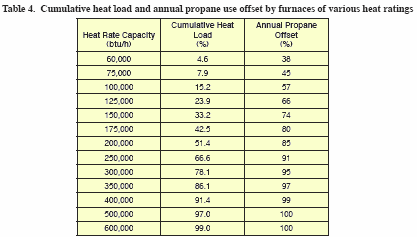
The prototype furnace we tested only had a peak heat output of 93,000 btu/h. An increase is needed to be able supply enough heat to meet the targeted fuel savings. A furnace can generate more heat either by (a) burning fuel at a faster rate, or (b) extracting more heat from each pound of fuel (that is, a better efficiency). Table 5 below shows how projected furnace output increases with increases in fuel feed-rates and furnace efficiencies. To get to 175,000 btu/h, a furnace could be designed to burn 100 lb/h with an improved 40% efficiency. Actually, both of these goals should be attainable in a commercial furnace.
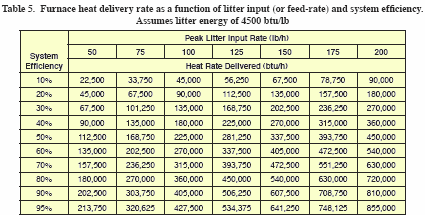
Assuming then, that a commercial furnace is available that puts out 175,000 btu/h and can reduce conventional fuel costs by 80%, what are the economic ramifications? A typical broiler house in northwest Arkansas requires about 5000 gallons of propane per year for space heating. An 80% reduction in propane consumption would represent a substantial dollar amount. Depending upon the price you are paying for propane, these savings could provide a net cash flow that could be invested in the litter fired furnace. The data in Table 6 below shows the total present value of projected fuel savings over a 7 year period. For example, if propane costs $1.20 per gallon and the furnace is capable of offsetting 80% of propane use, then the total present value of those fuel savings is $24,000, based on an interest rate of 8.5% and a 7 year planning horizon. Under this scenario, the grower could afford to invest (or borrow) as much as $24,000 for the furnace and expect the fuel savings to pay the note.
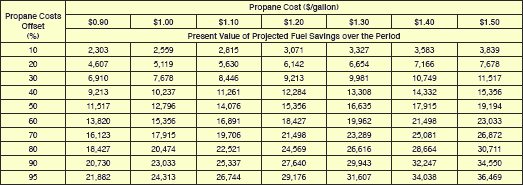
Clearly there are potential scenarios that provide economic feasibility for litter fired furnaces. The grower will, however, need to make sure that the purchase/installation costs do not exceed the fuel savings potential of the furnace during a reasonable payback period. Growers will need to inspect the manufacturer's specifications for the furnace heat rate capacity, fuel feed-rate and efficiency to see if propane savings will meet expectations.
Fuel and Ash Handling Projections:
For a grower interested in a litter-fired furnace, an additional question may be “How much litter and ash will I need to handle?” If we assume a litter-fired furnace has a 40% efficiency rate and our target is a reduction of propane usage by 80%, then about 100 tons of litter would need to be stored for fuel. This amount of litter is about the amount of litter produced by a 40 x 400 ft house annually. However, less storage capacity would be needed if litter cleanouts occur more frequently than once per year.
To store 100 tons of litter, a grower could build a lowcost temporary storage adjacent to the poultry house and furnace. A pile that is 20 ft wide at the bottom, would need to be approximately 80 ft long to store 100 tons. A heavy duty plastic tarp would be required to keep rain off the litter during storage (see Avian Advice 2(1):12-15). Remember that litter should not be stored at depths more than 5 ft to avoid spontaneous combustion in the pile.
We estimate that burning 100 tons of litter per year would produce about 12 tons of ash. Ash has a density of approximately 45 lb/ft3, which means that about 20 cubic yards of ash would need to be marketed or disposed of each year. The grower would need enough ash storage capacity to handle ash generated. The costs to transport ash should be much lessthan for transporting litter itself. The mass reduction is 8:1 and the volume reduction is 10:1 for the ash produced from burning litter. However, the consideration of what to do with ash should be determined prior to beginning furnace operation. Potential markets for litter ash include its use as an additive in concrete, and for use in fertilizer manufacture.
Conclusions:
An existing litter-fired furnace prototype is capable of burning broiler litter at a rate of nearly 1 ton per day (peak). This technology is a potential alternate use for poultry manure. In sensitive watersheds, its use could shunt many tons of litter from land application to on-farm combustion. As a BMP, it has the potential to decrease the movement of phosphorus and other nutrients from upland areas to surface waters. System performance of the tested prototype would need to be improved in order to make the system economically feasible. Simple design improvements, if implemented by the manufacturer, could increase system efficiency to 40% and increase fuel feed-rate to 100 lb per hour. Such improvements would mean that the furnace would likely reduce costs for propane (or natural gas) for space-heating by approximately 80% annually. Fuel savings of this magnitude are significant.
March 2007










